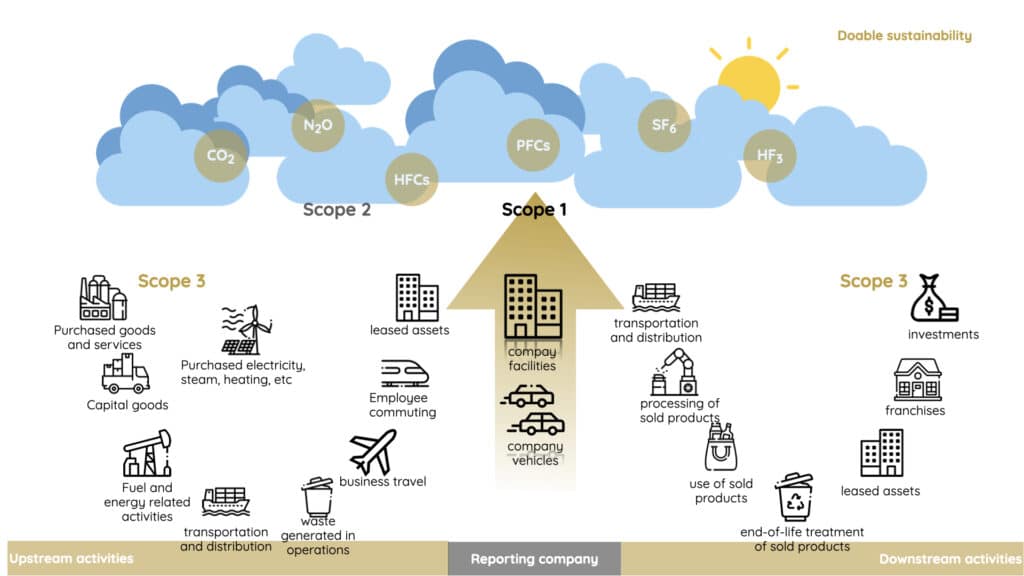When you talk about carbon footprint, you automatically think in terms of climate change, global warming, pollution, emissions and most likely CO2, but that idea encompasses much more.
What is carbon footprint?
It is an environmental indicator that measures the greenhouse gases (expressed in tons of CO2 equivalents) emitted directly or indirectly by an individual, a defined activity, product or organization.
What is meant by tons of CO2 equivalent, is to take a single, quantifiable reference point to be able to analyze the impacts of our activities.
According to the Kyoto Protocol, there are six major greenhouse gases responsible for climate change and each with a different global warming potential. The warming effect of carbon dioxide (CO2) has been assigned a value of “1” and the rest, which are not carbon dioxide, are attributed a warming potential referred to in carbon dioxide in CO2 equivalents (CO2-e), which is only a conversion factor.
| GHG | Formel | Warming potential | Source |
|---|---|---|---|
| Carbon dioxide | CO2 | 1 | Mainly from fossil fuel use |
| Methane | CH4 | 28 | Mainly from ruminant animals and organic waste |
| Nitrous oxide | N₂O | 265 | Mainly from agriculture |
| Hydrofluorocarbons | HFC | <13.900 | Mainly from refrigerants |
| Perfluorocarbons | CnF2n+2 | <12.400 | From aluminium production |
| Nitrogen trifluoride | NF3 | <17.200 | Mainly electronics industry |
| Sulphur hexafluoride | SF6 | 23.500 | Mainly from the electricity industry |
What’s it for?
It is used as a calculation tool to know the environmental impact of a product, process, etc. and is applicable to any organization, regardless of its size. By evaluating “how contaminating my process or product is” you can analyze where you can optimize and improve. This will always not only mean an economic benefit (lowering energy costs), but it also means anticipating future requirements and regulations and improving the image of how we present ourselves to society or to our customers, shareholders, employees…
How is it calculated?
The calculation will depend on whether what is to be evaluated is a complete organization or a product or service, with application standards for both the calculation and the certificate.
- Carbon footprint of an organization: covers all business sectors within the organization: GHG Protocol, ISO 14064-1
- Carbon footprint of products or services: covers the greenhouse gas emissions of the organization and the life cycle of the products: PAS 2050, ISO 14067
Whether it is a standard or another, in any case the first thing that has to be done in a Greenhouse Gas Inventory, which is nothing more than a document indicating the greenhouse gases (GHG) of an organization in a given period of time, usually one year. In this document, companies must differentiate between three types of emissions, with Scope 1 and 2 being almost obligatory:
- Direct emissions or Scope 1: they come from sources that are owned or controlled by the company. For example, fuel from the organization’s car fleet, or fuel needed for office heating
- Indirect emissions from energy o Scope 2: these are emissions that are a consequence of the organisation’s activities, but which are supported by another supplier. For example, electrical energy.
- Other indirect emissions o Scope 3: attributable to products and services acquired by the organisation and are the most difficult to calculate. They depend on products or services that are used by the organisation.

After the inventory, the calculations will be made according to each scope. This shall be done using reliable emission factors, such as those set out in Table 1. Emission data from the energy mix published by local ministries will also be used and calculation rules will be applied. For example, ISO 14064:2006 establishes a simple calculation formula:
Greenhouse gas emissions = Activity * EF*(1-ER/100)
Where:
- Activity: is the amount of fuel, kWh consumed, etc
- EF: is the emission factor for each activity data
- ER: overall emission reduction efficiency, %.
The independent calculation of each range allows us to compare where the bulk of our emissions are and to be able to attack that flank. The sum of the emissions from the three scopes will give us the overall impact of our organization.
Total emissions = GHG Scope 1 + GHG Scope 2 + GHG Scope 3
There are different agencies that offer carbon footprint calculators, for example:
- Canada: GHG and CAC calculator
- New Zealand: CO2 Emission Calculator
- EEUU: Greenhouse Gas Equivalencies Calculator
But what about my personal carbon footprint?
Every person, by the mere fact of their existence, produces emissions. Under the name “personal carbon footprint” the volume of greenhouse gases (GHG) generated by our actions is shown and therefore we can see the personal impact we have on global warming.
There are some public and official tools to make such a calculation, for example:
References & Resources
- EPA
- IPCC
- GHG Protocol
- OECD
- Andrew John East (2008) What is a Carbon Footprint? An overview of definitions and methodologies
- Photo by Callum Shaw on Unsplash
- Flaticon: Freepick – Icowixar – Mavadeee



